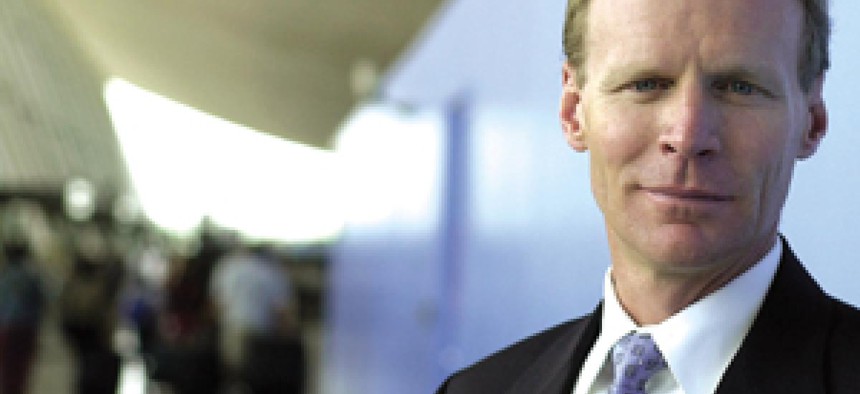Tech Success: Unisys, Daon help travelers fly through lines

On July 7 at Minneapolis-St. Paul International Airport the nation's first registered travelers sped through screening by placing their fingers on biometric readers in a pilot program launched by the Transportation Security Administration and Unisys Corp.
On July 7, security lines at Minneapolis-St. Paul International Airport parted, and the nation's first registered travelers sped through screening by placing their fingers on biometric readers. In the first hour, about 100 flyers bypassed long lines to reach their flights under a pilot program launched by the Transportation Security Administration and Unisys Corp.Unisys of Blue Bell, Pa., and EDS Corp. of Plano, Texas, last month won contracts worth $2.5 million and $1.3 million, respectively, to launch TSA's Registered Traveler pilot program at five U.S. airports. Under Registered Traveler, frequent flyers voluntarily provide TSA with personal information, including biometric identifiers, and use dedicated security lanes and expedited screening.Is the project a tech success? It may be too early to tell. Just days into the pilot, Unisys officials said the system was working flawlessly. Still, TSA will run 90-day pilots at five U.S. airports and evaluate results before deciding whether to permanently roll it out.What has been a success, the principals involved said, was how quickly the technology required for Registered Traveler was brought online, which suggests that opportunities exist to rapidly develop and deploy similar security systems."This program will allow us to quickly learn a lot about using biometrics for identification," said TSA spokesman Darrin Kayser.A key component of Unisys' biometric solution for Registered Traveler, and one that let the company start enrolling volunteers within days of the contract award, is software from Daon Inc. in Herndon, Va. The company develops identity management software for use in authentication systems such as Registered Traveler.TSA had asked contractors to propose solutions that incorporated multiple identifiers. In Minneapolis, Unisys picked fingerprint and iris-scanning capabilities.Multiple biometrics has been touted by experts as the wave of the future in government programs, such as the Defense Department's Common Access Card program, which will likely be upgraded to include more than one biometric identifier. "The reason the requirement came out for two biometrics is because TSA wanted to ensure accuracy, and one biometric is not completely accurate," said Larry Zmuda, a partner at Unisys overseeing the Minneapolis project.DaonEngine software is designed to support multiple biometrics, said Tom Grissen, Daon's chief executive officer. The software sits between biometric readers and the databases that hold people's records. When someone puts a finger on a reader, DaonEngine handles the authentication process.Written in Java, DaonEngine is vendor-, device- and algorithm-independent, so it can be used with almost any biometric solution and database. In Minneapolis, Unisys chose a fingerprint solution from Sagem Morpho Inc., an iris scanner from Panasonic USA and an Oracle database."Integrators can take advantage of the best device technologies, the best algorithms ... and spend a lot less energy" putting them together, Grissen said. That's especially important in light of government requests for proposals that specify off-the-shelf biometric components, he added."In putting together the team, we had to find partners who could deploy a system quickly," Unisys' Zmuda said.A week after winning the contract, Unisys and partner Northwest Airlines were enrolling passengers in Minneapolis. In the Minneapolis pilot, fingerprints are the primary identifier, and iris scans are the backup. Grissen said the process, including fingerprint and iris scan, took about five minutes. TSA had hoped to enroll 2,000 passengers in Minneapolis, Kayser said. By the time the Registered Traveler lanes were open, 2,400 people had already enrolled."There has been a lot of interest in this program," Kayser said.In addition to biometrics, DaonEngine supports other types of authentication, such as smart cards. Zmuda said Unisys will tap those capabilities when it launches Registered Traveler pilots at Los Angeles International Airport later this month, and at Houston's George Bush Intercontinental in August. For those pilots, Unisys will combine biometrics and smart-card technology in a token authentication system. flyers will present a card that carries their biometric information, and it will have to match a scan taken at the security kiosk."Because we're experimenting with new technologies, we're allowing contractors to experiment as well," Kayser said. "If there is a national rollout, and that is feasible, we have to have looked at a number of applications." When Unisys chose Daon's technology, the company was mindful of the possibility of a national rollout and the competition that would precede it, Zmuda said. With an enterprise authentication layer such as DaonEngine, the solution scales easily, he added."Fortunately, the Daon solution can adapt to changing requirements," Zmuda said.If you have an innovative solution that you recently installed in a government agency, contact Staff Writer Brad Grimes at bgrimes@postnewsweektech.com.


Tom Grissen, Daon Inc.'s chief executive officer, said the company's software is designed to support multiple biometrics.
J. Adam Fenster
NEXT STORY: The next step in network-centric warfare